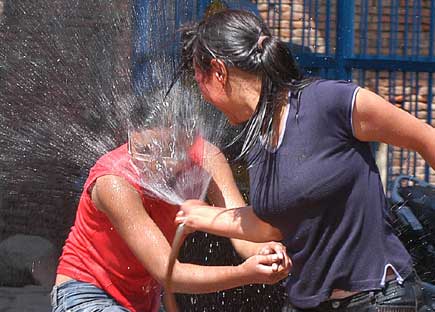This Sunday (20-03-11) is the Hindu Spring Festival, Holi.
A long, long, long, long, long time ago lived Prahlada, son of the demon king Hiranyakashipu and fervent devotee of Lord Vishnu. His dad was rather arrogant (due to being almost immortal) and did not like that his son continued to pray to Lord Vishnu. In order to put a stop to this, he decided to kill his son.
 Because of Prahlada’s faith & continuing prayer, however, all attempts at murder were twarthed. Poison was turned into nectar and trampling elephants and poisonous snakes did not harm him. As a last resort, Hiranyakashipu told his son to go to his sister, Holika, and sit on her lap. Holika had the handy power of not being able to be burned by fire, and the intention was clearly for loyal Prahlada to burn to death. However, due to his unwavering devotion to Lord Vishnu he remained perfectly safe, whereas his aunt was burned to death, instead.
Because of Prahlada’s faith & continuing prayer, however, all attempts at murder were twarthed. Poison was turned into nectar and trampling elephants and poisonous snakes did not harm him. As a last resort, Hiranyakashipu told his son to go to his sister, Holika, and sit on her lap. Holika had the handy power of not being able to be burned by fire, and the intention was clearly for loyal Prahlada to burn to death. However, due to his unwavering devotion to Lord Vishnu he remained perfectly safe, whereas his aunt was burned to death, instead. It is this burning of Holika that is celebrated in the Holi Spring Festival, every year on the last full moon of the month Phalguna (beginning on the 20th of February and ending on the 21st of March).
The celebrations for this joyful holiday include (small) bonfires (on the day before Holi) and the throwing around of colourful powders & (scented) water on Holi itsel.
The celebrations for this joyful holiday include (small) bonfires (on the day before Holi) and the throwing around of colourful powders & (scented) water on Holi itsel.
Originally, the colourful powders were made from the first spring flowers and medicinal herbs, to counter the fevers and cold linked to the changing weather in spring. The festival has become increasingly commercial, however, and synthetic colours are used more and more often.
This brings us to the fundamental eco- & human-unfriendliness of the current aspects of the festival.
The dyes (pastes, dry & water colours) contain many elements which could lead to severe health damage: heavy metals, acids, alkalis, powdered glass, copper sulphate, lead oxide, aluminium bromide, mercury sulphide, asbestos, silica and many others, leading to cancer, asthma, eye and skin problems,... These colours are often sold by street vendors who have no clue as to the origins (or contents) of their products, which are a lot cheaper than the original “herbal” colours.
The dyes (pastes, dry & water colours) contain many elements which could lead to severe health damage: heavy metals, acids, alkalis, powdered glass, copper sulphate, lead oxide, aluminium bromide, mercury sulphide, asbestos, silica and many others, leading to cancer, asthma, eye and skin problems,... These colours are often sold by street vendors who have no clue as to the origins (or contents) of their products, which are a lot cheaper than the original “herbal” colours.
And of course, these colours don’t just disappear after Holi. They seep into the ground where they mix with the precious & limited amount of drinking water available in India... (for more information on the toxicity of the dyes, see the informative document by ToxicsLink)
Another environmental issue is the “small wood fires” that are organized by most households on the day before Holi. According to the Times of India, approximately 30,000 Holi Fires are lit in the Gujarat. This amounts to 30,000 tonnes of wood, or around 7,500 trees. Trees that no longer act as a carbon sink, no long recycle water, no longer control soil erosion, but instead produce tonnes of CO2 by being burnt.
Suggestions of a lesser number of fires or of the burning of waste-products instead of cutting down trees have been largely ignored...
Suggestions of a lesser number of fires or of the burning of waste-products instead of cutting down trees have been largely ignored...
 Another issue is the amount of water that is spilt during the festival. It is common to make water balloons or to hose your friends & neighbours (or innocent passer-bys). If you take into account, however, that it will still take at least another month before the arrival of the Monsoon and its luscious rains, it is remarkable how much water is being squandered (water that will be sorely missed when the monsoon arrives later and all water has to be rationed)...
Another issue is the amount of water that is spilt during the festival. It is common to make water balloons or to hose your friends & neighbours (or innocent passer-bys). If you take into account, however, that it will still take at least another month before the arrival of the Monsoon and its luscious rains, it is remarkable how much water is being squandered (water that will be sorely missed when the monsoon arrives later and all water has to be rationed)...So, if you’re planning to go Wild on Holi this year, think of the environment and your own health, make your own colours & contribute to a communal bonfire instead of making your own & try to waste as little water as possible...





Beautiful photos, very nice article.
ReplyDeleteToo bad that so much fun also involves the waste of precious water and wood but with all the waste around us for the wrong reasons at least this one seems to bring lots of joy......oh, well we never win.....do we?